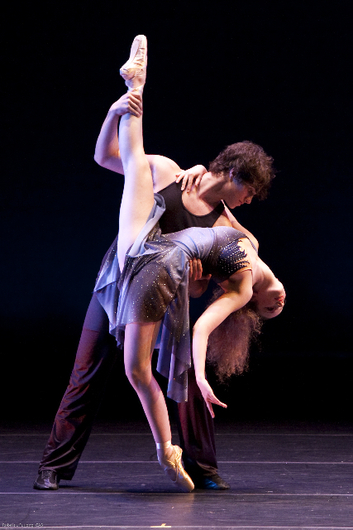Pointe Work The study of pointe work is a serious endeavor and must only be taken on by the most dedicated of ballet students. Pointe dancing requires a commitment to dance studies. Any dancer being considered for pointe class must also take, at a minimum, two ballet technique classes per week. The following guidelines are followed by NYAB as quoted from The Pointe Book written by Janice Barringer and Sarah Schlesinger:

When Is A Dancer Ready To Go On Pointe?
"The most pressing question facing a teacher of pointe is how best to determine a student’s readiness to begin pointe training. During our interviews with medical specialists and master teachers we concluded that there is no simple answer to this question. There is much that the teacher must consider a combination of factors including the age, anatomy, bone development, strength, length of training, weight and attitude of a student before making this judgment."
In his book Dance Technique and Injury Prevention, Dr. Justin Howse, orthopedist for the Royal Ballet School, says that for many years twelve was considered the age to begin pointe work. He feels that there is no particular age at which pointe work should begin. Dr. Howse states, “The only factor which matters is the state of the development of the child, and to be dogmatic about an age does not make any reference to the child’s maturity or immaturity.”
Howse adds that there is no shame or disadvantage in beginning pointe work at a later age, while an early start before physical and technical readiness are present can be potentially harmful. A dancer who waits to go on pointe until the correct time for her particular body and skill development level will have less risk of injury, be able to achieve the correct technique with greater ease and progress more speedily. He notes that a number of well-known dancers were not strong enough to start pointe work until they were teenagers, but found this no handicap to their careers.”
"The most pressing question facing a teacher of pointe is how best to determine a student’s readiness to begin pointe training. During our interviews with medical specialists and master teachers we concluded that there is no simple answer to this question. There is much that the teacher must consider a combination of factors including the age, anatomy, bone development, strength, length of training, weight and attitude of a student before making this judgment."
In his book Dance Technique and Injury Prevention, Dr. Justin Howse, orthopedist for the Royal Ballet School, says that for many years twelve was considered the age to begin pointe work. He feels that there is no particular age at which pointe work should begin. Dr. Howse states, “The only factor which matters is the state of the development of the child, and to be dogmatic about an age does not make any reference to the child’s maturity or immaturity.”
Howse adds that there is no shame or disadvantage in beginning pointe work at a later age, while an early start before physical and technical readiness are present can be potentially harmful. A dancer who waits to go on pointe until the correct time for her particular body and skill development level will have less risk of injury, be able to achieve the correct technique with greater ease and progress more speedily. He notes that a number of well-known dancers were not strong enough to start pointe work until they were teenagers, but found this no handicap to their careers.”